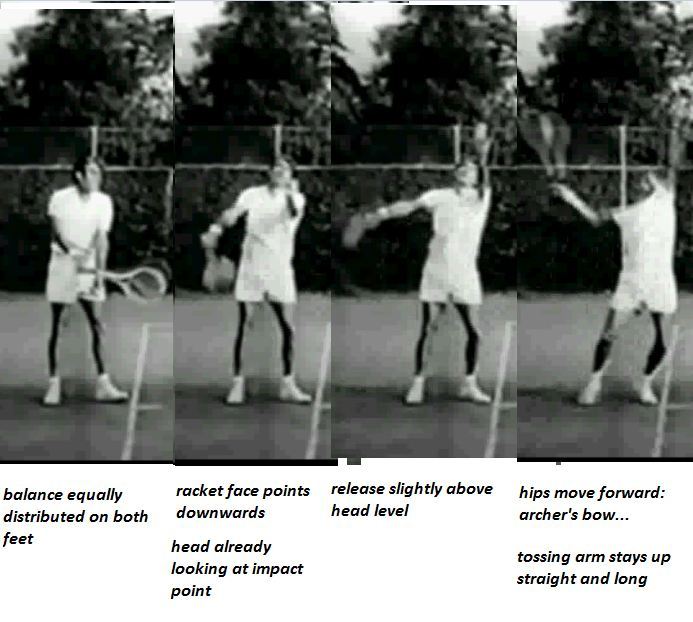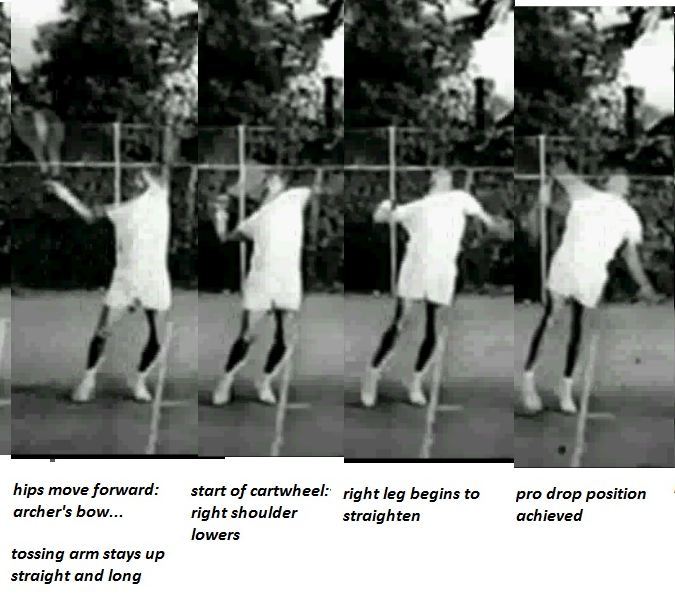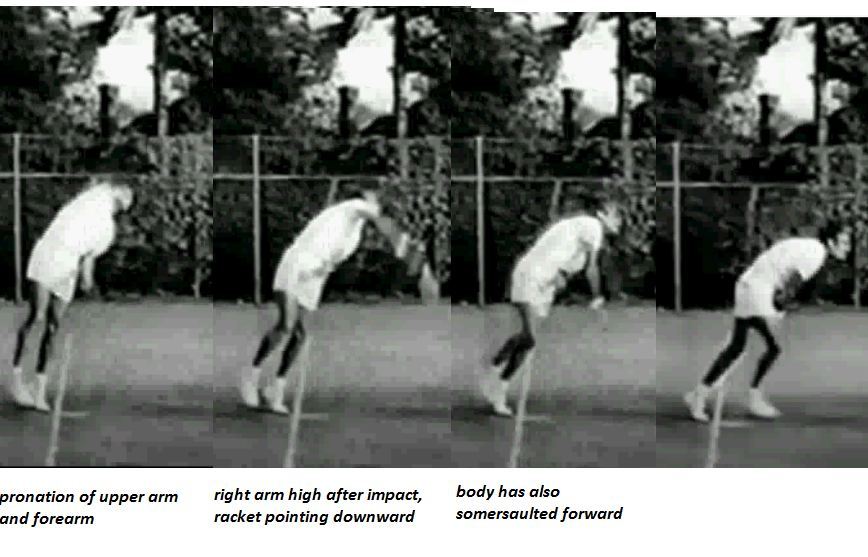The Richard Gonzales Service Motion...
In describing the motion of the Richard Gonzales service motion from a set of still pictures it is important to describe the motion although identifying the static positions can be helpful. If given a set of 11 pictures we can blend them or connect the dots we can successfully begin to understand what exactly it is that makes this motion so effective and perhaps describe it to a student so that it makes sense to them.
Frame #1...Gonzales in his ready position. Ready position is standing relatively relaxed and notice the position of the racquet head. Actually I believe that this is not the initial position that he has started from as his tossing hand has already descended. But from his ready position he is in position so that his racquet arm can swing freely backwards. Pay close attention to the shape of his racquet, his wrist and hand, and his arm.
Frame #2...The racquet head has already past the point of the lowest point in the swing and the racquet arm has begun to lift. Both hands are lifting simultaneously. Most important is that the racquet arm and racquet are in exactly the same shape that they were in the frame before. It is difficult to see from the still frames but this motion is actually a turning of the shoulders and Gonzales is allowing gravity to dictate the path of the racquet head and gripping the racquet only tight enough to hold the structure in the same shape. On a scale of one to ten I would guess that the pressure on the grip is about two or three. It is important that there be a complete absence of tension throughout the swing.
It is only the weight of the racquet head and the slight turning shoulders that have swung the racquet back this far.
Frame #3...Once again take notice of the structure of the racquet and arm. It has not changed one iota from the initial look in the starting position. Now the racquet head is “climbing up the hill” with a further turning of the shoulders and only enough lifting from the arm as is necessary to get the thing to the top of the hill. The slow and languid backswing is a reflection of the topography. Going up hill, gravity is making things a bit slower and heavier. His shoulder are aiming at the target. The tossing arm is going upwards from his side at this point but this is a bit misleading and he has not released the ball. If he releases the ball here he is going to have to do some manipulation with the toss to get it in front of him to go forwards to propel himself to the net.
Frame #4...Gonzales is at the most critical juncture of his swing in this frame. Notice how the knees are bending and he is just beginning to lean backwards slightly. These are leads that the racquet head is going to follow as it reaches the zenith of the backswing. The highest point. It looks to me here that the arm and racquet structure has undergone minimal change and this is another indication that the body rotation has supplies nearly all of the inertia to get the racquet where it is in the backswing. This is incredibly important...because this is what this great motion owes its silky rhythm to. Incredible engagement with all of the body parts acting together with gravity dictating the speed of the motion.
Frame #5...The racquet head has begun it’s descent into the loop behind his back. This is the point where all of the incredible racquet speed is being developed. As he leans further backwards the racquet is given further room to “drop” behind him. The shoulders have also completed there rotation here as if there was a frontal view you would see that his left shoulder is turned to the right net post. Again it is important to note there there is minimal tension in the arm, wrist and hand (the grip) as the arm and racquet structure collapses under the position of the racquet head. This loop behind his back is like the loop in a roller coaster ride where the intense g-forces are building in order to send the racquet head screaming towards the ball.
Frame #6...Three things are occurring simultaneously here. First there is the leg drive and secondly there is the rotation back of the shoulders. These two components are initially driving the racquet head down into its deepest descent behind his back. The action forwards (and upwards) has begun in earnest.
Frame #7...Here the legs have done their work and the shoulders continue to rotate and it is the arm that is coming into play at this point. Still maintaining a relaxed and loose grip on the racquet the arm and racquet are being catapulted towards the ball with the throwing motion of the arm. The most important thing here to note is that all of this motion has been leading up to this climactic moment. It is the relaxed composure that allows all of this free swinging. Any “conscious effort” to apply muscle to this equation is going to be self defeating with the aspiration of hitting “harder”. To hit harder you must swing freer. Less effort actually equals more potential energy in the racquet head.
Frame #8...The moment of truth is the impact of the racquet head on the ball. The racquet head is moving at the fastest speed here. All of this motion has added up to this collision. The trajectory of the racquet head is moving up to the ball and the face is going across the back of the ball to give it spin. Spin being the most actionable objective in the service motion. By subtly manipulating the angle of the wrist spin is applied in more or less amounts. While speed is certainly a very important element in the power of a serve it is spin that will more efficiently contribute to placement and variety of delivery.
Frame #9...The racquet head and arm appear to have been shot over a barrel. The trajectory of the racquet head has cast a wide circle in front of Gonzales and it is obvious from the leaning position of his body he has only one thought going on and this thought is one of heading towards to the net to capitalize on a weak return from his opponent. All thoughts of his service motion are behind him because at this very split moment he knows what exactly his serve is going to do and what effect it is going to have on his opponent. He has already calculated on the different varieties of service returns this particular opponent may have a chance at and he is going to the point where he has calculated where the percentage return shall be. He has ruled out a certain part of his court and he is going to cover and put himself in the best position possible to assume total command of the point.
Frame #10...Back foot swinging through. On his way to the net.
Frame #11...First step in the journey to the net. Cat...pouncing on prey.
The thing that makes this motion a radical departure from the motions of today…is only one thing. He is headed to the net. You can talk about any rule changes in the foot fault rule all that you want. It is only that he is headed to the net. Of course nobody is headed to the net these days. Are they?

Originally posted by gzhpcu
View Post
In describing the motion of the Richard Gonzales service motion from a set of still pictures it is important to describe the motion although identifying the static positions can be helpful. If given a set of 11 pictures we can blend them or connect the dots we can successfully begin to understand what exactly it is that makes this motion so effective and perhaps describe it to a student so that it makes sense to them.
Frame #1...Gonzales in his ready position. Ready position is standing relatively relaxed and notice the position of the racquet head. Actually I believe that this is not the initial position that he has started from as his tossing hand has already descended. But from his ready position he is in position so that his racquet arm can swing freely backwards. Pay close attention to the shape of his racquet, his wrist and hand, and his arm.
Frame #2...The racquet head has already past the point of the lowest point in the swing and the racquet arm has begun to lift. Both hands are lifting simultaneously. Most important is that the racquet arm and racquet are in exactly the same shape that they were in the frame before. It is difficult to see from the still frames but this motion is actually a turning of the shoulders and Gonzales is allowing gravity to dictate the path of the racquet head and gripping the racquet only tight enough to hold the structure in the same shape. On a scale of one to ten I would guess that the pressure on the grip is about two or three. It is important that there be a complete absence of tension throughout the swing.
It is only the weight of the racquet head and the slight turning shoulders that have swung the racquet back this far.
Frame #3...Once again take notice of the structure of the racquet and arm. It has not changed one iota from the initial look in the starting position. Now the racquet head is “climbing up the hill” with a further turning of the shoulders and only enough lifting from the arm as is necessary to get the thing to the top of the hill. The slow and languid backswing is a reflection of the topography. Going up hill, gravity is making things a bit slower and heavier. His shoulder are aiming at the target. The tossing arm is going upwards from his side at this point but this is a bit misleading and he has not released the ball. If he releases the ball here he is going to have to do some manipulation with the toss to get it in front of him to go forwards to propel himself to the net.
Frame #4...Gonzales is at the most critical juncture of his swing in this frame. Notice how the knees are bending and he is just beginning to lean backwards slightly. These are leads that the racquet head is going to follow as it reaches the zenith of the backswing. The highest point. It looks to me here that the arm and racquet structure has undergone minimal change and this is another indication that the body rotation has supplies nearly all of the inertia to get the racquet where it is in the backswing. This is incredibly important...because this is what this great motion owes its silky rhythm to. Incredible engagement with all of the body parts acting together with gravity dictating the speed of the motion.
Frame #5...The racquet head has begun it’s descent into the loop behind his back. This is the point where all of the incredible racquet speed is being developed. As he leans further backwards the racquet is given further room to “drop” behind him. The shoulders have also completed there rotation here as if there was a frontal view you would see that his left shoulder is turned to the right net post. Again it is important to note there there is minimal tension in the arm, wrist and hand (the grip) as the arm and racquet structure collapses under the position of the racquet head. This loop behind his back is like the loop in a roller coaster ride where the intense g-forces are building in order to send the racquet head screaming towards the ball.
Frame #6...Three things are occurring simultaneously here. First there is the leg drive and secondly there is the rotation back of the shoulders. These two components are initially driving the racquet head down into its deepest descent behind his back. The action forwards (and upwards) has begun in earnest.
Frame #7...Here the legs have done their work and the shoulders continue to rotate and it is the arm that is coming into play at this point. Still maintaining a relaxed and loose grip on the racquet the arm and racquet are being catapulted towards the ball with the throwing motion of the arm. The most important thing here to note is that all of this motion has been leading up to this climactic moment. It is the relaxed composure that allows all of this free swinging. Any “conscious effort” to apply muscle to this equation is going to be self defeating with the aspiration of hitting “harder”. To hit harder you must swing freer. Less effort actually equals more potential energy in the racquet head.
Frame #8...The moment of truth is the impact of the racquet head on the ball. The racquet head is moving at the fastest speed here. All of this motion has added up to this collision. The trajectory of the racquet head is moving up to the ball and the face is going across the back of the ball to give it spin. Spin being the most actionable objective in the service motion. By subtly manipulating the angle of the wrist spin is applied in more or less amounts. While speed is certainly a very important element in the power of a serve it is spin that will more efficiently contribute to placement and variety of delivery.
Frame #9...The racquet head and arm appear to have been shot over a barrel. The trajectory of the racquet head has cast a wide circle in front of Gonzales and it is obvious from the leaning position of his body he has only one thought going on and this thought is one of heading towards to the net to capitalize on a weak return from his opponent. All thoughts of his service motion are behind him because at this very split moment he knows what exactly his serve is going to do and what effect it is going to have on his opponent. He has already calculated on the different varieties of service returns this particular opponent may have a chance at and he is going to the point where he has calculated where the percentage return shall be. He has ruled out a certain part of his court and he is going to cover and put himself in the best position possible to assume total command of the point.
Frame #10...Back foot swinging through. On his way to the net.
Frame #11...First step in the journey to the net. Cat...pouncing on prey.
The thing that makes this motion a radical departure from the motions of today…is only one thing. He is headed to the net. You can talk about any rule changes in the foot fault rule all that you want. It is only that he is headed to the net. Of course nobody is headed to the net these days. Are they?









Comment